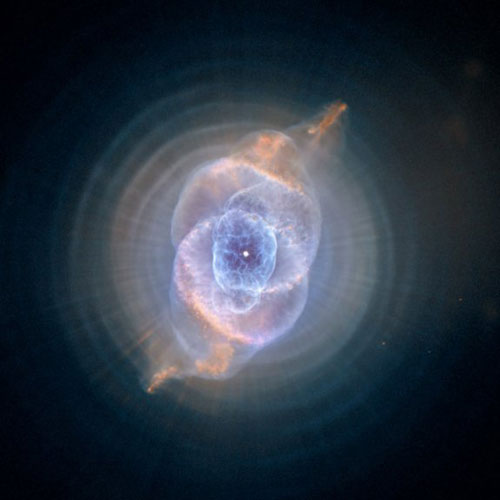New Clues to the Most Amazing Shapes in Space

The term "planetarynebula" has always been a misnomer, but these spectacular clouds of dustand gas may actually have something to do with planets after all, astronomershave found.
Whenastronomers discovered these celestial objects 300 years ago, they couldn'ttell what they were and so named them for the resemblance they had to the planetUranus as seen through early, relatively crude telescopes. But by the mid-19thcentury, it was realized that they were actually greatclouds of dust emitted by dying stars.
Now,researchers at the University of Rochester have found that low-mass stars orpossibly even giant gas planets orbiting these aged stars could be pivotal increating some of the nebulae's unusual shapes.
"Fewresearchers have explored how something as small as a very low-mass star, abrown dwarf or even a massive planet can produce several flavors of nebulae andeven change the chemical composition of the dust around these evolvedstars," said study leader Eric Blackman. "If the companions can bethis small, it's important because low-mass stars and high-mass planets arelikely quite common and could go a long way toward explaining the many dustyshapes we see surrounding these evolved stars."
The team'sresearch is detailed in papers in the Astrophysical Journal Letters andthe Monthly Notices of the Royal Astronomical Society and was funded byNASA and the National Science Foundation.
End oflife
Planetarynebulae are the last stage of life for most medium-sized stars, such as ourSun. This stage only lasts for several tens of thousands of years?a blink of aneye in the star's 10 billion year lifespan. Of the 200 billion stars in the Milky Way, only about 1,500 have beenfound to be in the planetary nebula phase. So that makes these glowing clouds arelatively rare sight.
Breaking space news, the latest updates on rocket launches, skywatching events and more!
The stagebegins as the star depletes its fuel near the end of its life. Its corecontracts and its envelope expands, eventually throwing off its outermostlayers millions of miles into space.
One time infive, the envelope keeps its spherical shape as it expands, forming a glowingorb. But more often, the envelope contorts into a dazzling array of shapes.
Spiral waves
Blackmanand his team explored the role that low-mass companion stars orsuper-Jupiter-sized planets might have in sculpting the shapes of planetarynebulae.
Theresearchers explored two scenarios: when the companion was in a large orbit andinteracted only with the very edges of the envelope, and when it was in a tightorbit, entirely engulfed by the envelope.
In a wideorbit, the companion star or planet's gravity begins to drag some of theenvelope material?essentially a thin mixture of gas and dust?around with it.The material becomes compressed in spiral waves that radiate out from thecentral star like a wagon wheel, Blackman said. The gas and dust continue tocompress until the spiral waves break like waves on a beach.
Eventually,a doughnut-shaped ring of dust forms around the star's mid-section, likelyblocking much of the expanding envelope, like a belt around an inflatingballoon. Over time, shapes like the aptly named DumbbellNebula can form.
Thisbehavior also accounts for the strange signature of crystallized dust thatastronomers have observed around evolved stars before the nebulae form.
"Asthe spiral waves break, they release their compressed, pent-up energy in aburst of heat, sufficient to melt the dust into liquid globules," Blackexplained. The globules cool slowly enough that the molecules within them havetime to align into crystal lattices.
Shortorbit
When acompanion's orbit is close to the main star, one of three outcomes is likely tooccur, the team found.
The companionstar or planet could spin up the envelope so quickly as it plows through thatthe material is ejected, deforming into a large disk or torus around the star'sequator.
Anotherpossibility is that the companion spins up the material more gently, causingthe inner regions of the envelope to spin faster than the outer regions. Thisdifference in motion could stretch and amplify the star's magnetic fields,which would then act like a giant spring, ejecting the envelope material outthe star's poles as jets.
The thirdscenario sees the companion itself ejecting out of the star's jets, Blackmansaid. This could happen if the companion star or planet was too small to ejectthe envelope material before it falls prey to the grasp of the main star'sgravity. The intense pull of the star can shred the planet as its orbitshrinks, eventually smearing it into a disk of turbulent debris around thestar. This debris would be ejected as jets with the envelope material.
The teamnow plans to investigate the mixing and transport of different chemicalelements within the nebulae to see how the distinct chemical signaturesdetected in planetary nebulae come about.
- Vote Now: The Strangest Things in Space
- Cause of Strange Cosmic Shapes Pinned Down
- Images: Nebulae

Andrea Thompson is an associate editor at Scientific American, where she covers sustainability, energy and the environment. Prior to that, she was a senior writer covering climate science at Climate Central and a reporter and editor at Live Science, where she primarily covered Earth science and the environment. She holds a graduate degree in science health and environmental reporting from New York University, as well as a bachelor of science and and masters of science in atmospheric chemistry from the Georgia Institute of Technology.
